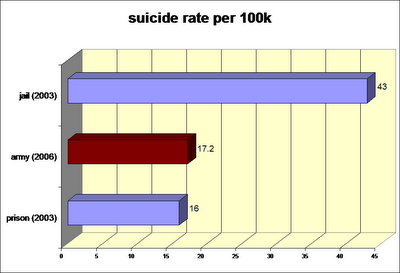 the st. paul pioneer press has developed a free searchable database for all ramsey county jail bookings. one can quickly and easily search by person, by date, or by offense category. it takes just a few seconds to pull up the full names and birth dates for, say, the 359 people booked for “no proof of insurance misdemeanors” or the 3 robert williams’ arrested since january 1, 2007.
the st. paul pioneer press has developed a free searchable database for all ramsey county jail bookings. one can quickly and easily search by person, by date, or by offense category. it takes just a few seconds to pull up the full names and birth dates for, say, the 359 people booked for “no proof of insurance misdemeanors” or the 3 robert williams’ arrested since january 1, 2007.
as a ramsey county resident, i’ve gotta admit that i’ll be tempted to use these data. i could easily run a search of the older dudes playing in tor’s bands and i’d certainly want to check out esperanza’s future suitors. as a sociological criminologist, however, this sort of thing makes me very nervous. here’s a bit of background on the site and the potential problems it raises.
the description:
This is a database of individuals who were arrested and booked into the Ramsey County Jail since Jan. 1, 2007. The data, obtained from the Ramsey County Jail, is updated Monday through Friday. You can search the data by either a person’s name, a type of violation or the date of arrest.
the disclaimers:
Individuals might be listed more than one time on the same date if they have multiple charges against them. Being listed here does not mean they have been charged in court with this offense…. Not all violations are listed here. In addition, inconsistencies in how the information is entered into the database may result in some arrests not be[ing] displayed.
the difficulties:
while data on arrests and bookings are generally considered public information, i’m surprised the pi-press and the jail took it upon themselves to publicize this information. aside from the dubious quality of arrest data in most jurisdictions, many of these folks will never even be charged with crimes, much less convicted.
for example, the gentleman in the photo above was arrested and booked many times — for trespassing, loitering, disorderly conduct, traffic offenses, parading without a permit, and other heinous crimes. how do you think prospective landlords or employers will respond when such a long record fills their computer screens? most men in cities, myself included, have been arrested at some point. would the minnversity have hired me if someone in HR stumbled on my (juvenile) arrest record in an online search? and don’t think you have to live in st. paul to be arrested there. those campus kids planning protests of the 2008 republican national convention, for example, have a fightin’ chance of landing in this database as well.
nevertheless, my main problem with the search engine is that it stops with arrest. those landlords and employers would need to do a lot of due diligence to determine whether those arrests ever went anywhere. they won’t do it and i can hardly blame them, because the quick search gives them the only screen they think they’d ever need.
 i felt woefully uninformed when i learned that senator larry craig (r-idaho) was picked up for lewd public restroom behavior at my airport. what’s all this about foot-tapping? and blocking the door with one’s luggage? this appears to be a well-choreographed old-school tearoom rather than an ill-timed individual act. there was apparently enough activity in this restroom to motivate the rather extensive sting operation that netted the distinguished senator.
i felt woefully uninformed when i learned that senator larry craig (r-idaho) was picked up for lewd public restroom behavior at my airport. what’s all this about foot-tapping? and blocking the door with one’s luggage? this appears to be a well-choreographed old-school tearoom rather than an ill-timed individual act. there was apparently enough activity in this restroom to motivate the rather extensive sting operation that netted the distinguished senator.







